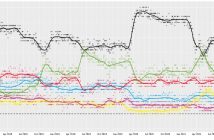The global warming caused by humanity since the industrial revolution has been found to be without parallel in the past two thousand years, in the latest blow to a climate skeptic myth.
Earlier hot and cold periods over the past two millennia, such as the “Roman warm period” that ended around the year 750, were previously thought to be global phenomena. That has led to climate change deniers to suggest that the current phase of warming could be a natural trend akin to these past fluctuations.
A new analysis has found strong evidence that four past natural fluctuations were actually regional events. They didn’t span the globe simultaneously, but often took centuries to move around the world. The lowest temperatures of the Little Ice Age, for example, were recorded in the 15th century in parts of the Pacific, the 17th century in north-western Europe and south-eastern North America, and not until the 19th century elsewhere in the world.
By comparison, the rise in temperatures over the past two centuries has been felt across 98 percent of the planet, reaching every corner apart from Antarctica. Such consistency over space is unprecedented in the past 2000 years.
“The contemporary warm period stands in stark contrast. It’s very different than what we see in the past,” says Nathan Steiger at Columbia University in New York. He says the findings should scotch arguments made by climate skeptics.
Steiger and his colleagues arrived at the results by reconstructing temperature records for two millennia from proxies including tree rings, coral and glacier ice. While the warm and cool periods before the industrial revolution were found to be within the realms of what could be expected by natural variations in the climate, today’s rapid and widespread period of warming was not.
Resource: New Scientist
Cover Photo: Bob Blob/Unsplash





